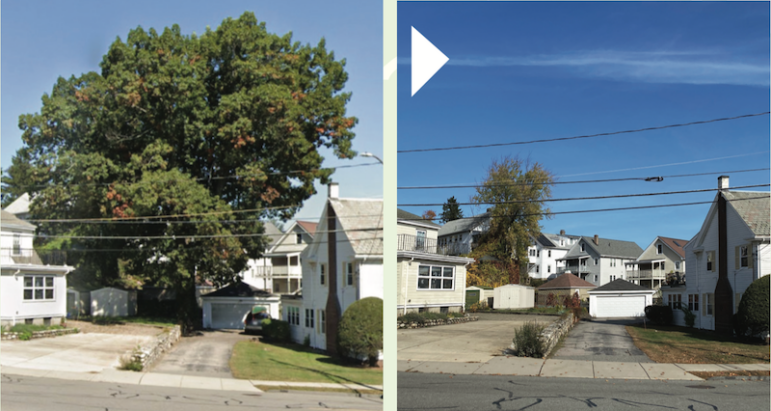
Submitted by Trees for Watertown
How is it that big urban trees play an absolutely vital role in protecting cities against climate change? And what can cities do to better protect these climate warriors? This is the message that Dr. William R. Moomaw will present at Watertown’s Free Public Library at Trees for Watertown’s annual meeting on Saturday, November 9 from noon to 2 p.m. This event is free and open to the public.
The news is full of stories about the brutal impact of climate change around the world. Shade trees play a key role in helping cities temper dangerously high temperatures and heavy flooding, so one way cities are preparing themselves is by planting trees. Planting trees now is hugely important for managing climate change in the future.
But young trees take decades to reach mature size. Meanwhile big urban trees are making major contributions NOW to managing climate change — by cooling the air and shading nearby heat- absorbing surfaces, by sucking up thousands of gallons of stormwater, and by storing away atmospheric carbon in their trunks, branches, and roots.
The outsize protective services that large, established urban trees provide NOW are disappearing, tree by tree, as those trees are cut down. A wise city works to protect this priceless resource.
William Moomaw is Professor Emeritus of International Environmental Policy at the Fletcher School of Tufts University, and Distinguished Visiting Scientist at Woodwell Climate Research Center. He has spent his professional lifetime working on climate change policy, and the last twenty years developing an understanding of the essential services that mature forests provide and promoting policies to protect them.
Trees for Watertown interviewed Dr. Moomaw in preparation for Saturday’s presentation. Here are a few of his comments from that interview.
TFW: Based on your findings, why is it that mature trees play such a critical role in urban environments like Watertown, especially in this year 2024, when climate change is clearly intensifying?
Dr. Moomaw: “The functions that trees in urban settings provide are multifold. All trees enhance the urban experience and all trees are important, but some trees are more effective in what they do than others. It is the older, bigger, mature trees that are keeping significantly more planet heating carbon dioxide out of the atmosphere than younger trees. In my presentation I’ll show just how many little trees it takes to do what just one big tree does. Keep in mind too that while many street tree species can live a century or longer, under current management conditions as many as 1 in 5 city trees die within a few years of planting, and few survive longer than about 20 years.”
TFW: Suppose a development plan for a new commercial or residential building is being proposed in Watertown. At that site, there is just one mature tree — for example, a 100-foot tall, 50-inch diameter oak tree. The developers propose to remove the tree but promise to plant a dozen new trees on the perimeter of the site to compensate for that big tree being cut down. Why isn’t this a ‘deal’ for Watertown?
Dr. Moomaw: “They’re totally different. First of all, they’ll probably plant saplings. It takes 465 robust landscape trees that are 25 feet tall and 4 inches in diameter to equal the amount of leaf area and the amount of wood and thus carbon stored, in one 100-foot tall, 56 inch diameter tree. They say: “We’ll replace it with one that’s a 50-foot-tall tree” — Well, you need about 36 50-foot-tall-trees that are already growing somewhere to equal that one big tree. You simply cannot replace the services of a big urban tree — not in your lifetime, and maybe not even in your children’s lifetime.”
Trees for Watertown is urging our City to establish a strong tree protection ordinance in recognition of the importance of shade trees to public health and well-being. We’re also asking Watertown to strengthen our Forestry Division with Certified Arborist and community outreach staff and state-of-the-art forestry management software, in order to better sustain and grow Watertown’s urban forest in partnership with the Watertown community.
If you’d like to learn more about Dr. Moomaw’s work and how it applies to Watertown, please come see Dr. Moomaw’s presentation at Trees for Watertown’s Annual Meeting at the Watertown Free Public Library, 123 Main Street, this Saturday, November 9th, from 12-2 p.m. Come in person, or visit treesforwatertown.org to register to attend on Zoom.
will this presentation be recorded? if so, where will we be able to find it?
Hi, Judy: WCATV has kindly agreed to record this event. It should be available on WCATV’s public channel around mid-week next week.